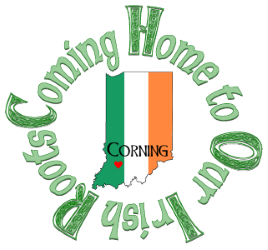Corning
Heritage Center
Our mission is to preserve the cultural legacy of nineteenth-century Irish immigrants in Southern Indiana.

History of Corning, Indiana
Corning, Indiana had a post office from 1893 until 1902, when it was closed, thus making Corning an unincorporated town in Reeve Township, Daviess County. That's all you'll get on Corning's Wikipedia page, but we all know that this small town is far more important than that short description!
Early Settlers
When most people hear about Irish immigration, they almost immediately think about the potato famine. However, the Irish immigrants who came to settle in Corning and the surrounding area were not from the exodus of Irish due to the potato famine. Most of our ancestors came before the potato famine, some as early as the 1810s. Work on the canals drew Irish workers to the area with the contruction of the Wabash and Erie canal that would cut across the top corner of Daviess County. Many of the Irish realized that there was plentiful land to be purchased in the county, and that was extremely desirable for a population who had long been denied the right to own property by the British landowners who held control over the people of Ireland for centuries. Once some of the Irish had settled here, they sent home for their families to join in the better life offered by the good farming in Daviess County. Gradually, a community grew up as the families stayed close together to share in their common heritage and dreams.
Many of the Irish who settled in Corning came from Counties Wexford, Kildare, Kilkenny, and Queen's. You can view this heritage written on many of the headstones in the Glencoe and St. Patrick's cemeteries.
Moving from Glencoe to Corning
There was much controversy surrounding the decision to move St. Patrick's Church from its original location in Glencoe to Corning. The main impetus for its removal was the growing population in Corning who didn't want to travel so far to attend mass. A great boon, however, made moving the church a logical choice. The Hughes family donated the land for the construction of the new church in Corning, and thus St. Patrick's Church was built in 1859 in Corning. The original priest's house was built in 1875 across the road from the church, using logs from the church at Glencoe. The current rectory was built in 1895 for $3,000, completing the site as it is now. Fun fact: the garage received an addition when the priest's long car wouldn't fit in the old building that was made for a buggy!
St. Patrick's Church, now called Celtic Hall, is one of the oldest examples of Gothic Revival that survives in Indiana. In 1990, the stained glass windows underwent restoration. In 2010, the Daviess County Historical Society received $10,000 from the Efroymson Family Fund to repair the roof of Celtic Hall, but further repairs were undertaken in 2017 with generous donations from the Knights of Columbus and our members to the CHC. Currently, we are seeking a grant to repair the bell tower, which threatens to topple due to interior and exterior deterioration.
Some Local Family Names
This list is not complete, and research keeps it growing! Here are some examples of names you'll see in the ancestry of Corning:
Bennett, Bradley, Breen, Brothers, Buckley, Burch, Burns, Butterly, Byrd, Byrne, Cahill, Callahan, Carlin, Cleary, Collins, Colvin, Conlin, Connaughton, Cooney, Conroy, Conway, Cormican, Craney, Cunningham, Curran, Cushing, Delaney, Derrig, Donahue, Donnolly, Dowling, Downey, Doyle, Drew, Dunn, Dwyer, Eagen, Elliott, Fanning, Farrell, Fegan, Fields, Fitzgerald, Fitzpatrick, Flanigan, Flynn, Gaede, Gallagher, Garan, Garegan, Gillin, Grannan, Griffin, Ham, Hand, Hart, Healy, Heffernan, Hevron, Hobin, Hopkins, Hughes, Jones, Kane, Kavanagh, Kehoe, Kellett, Kelly, Kennedy, Lamb, Langton, Larkin, Lenen, Lonergan, Mackell, MacTaggert, Mahan, Matthews, McCabe, McCarthy, McDonnell, McLaughlin, Meehan, Meloy, Mines, Molloy, Morgan, Morin, Mullen, Murphy, Murray, Nalin, Nolan, Nugent, O'Connor, O'Maley, O'Neill, Parson, Pettigrew, Pinion, Reagan, Riley, Ryan, Saul, Sellers, Shea, Smith, Summers, Toy, Walsh, Wilson.
The Start of the CHC
After the closure of St. Patrick's Church in the 1990s, the buildings began to fall into disrepair. With permission from the Evansville Diocese, several former members of St. Patrick's Church took stewardship of the buildings to help maintain them and prevent their destruction. A board was formed to create the Corning Heritage Center with the expressed dual purposes of maintaining the site and promoting Irish heritage awareness. Over the years, the board was able to take full responsibility for the property from the Evansville Diocese though the attached cemeteries at St. Patrick's and Glencoe are still under the perview of the Diocese. The CHC board strives to maintain the buildings in a state as close to their original construction as possible. This is a costly endeavor, but we feel that this is the best way to preserve our Irish heritage.
Corning Today
While Corning remains a small unincorporated town in southern Daviess County, it has a large place in the hearts of those connected to it. When we're in Corning, we're coming home to our Irish roots!